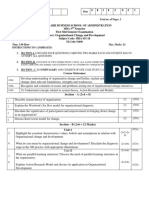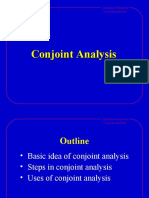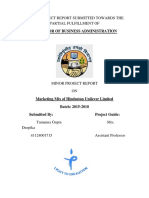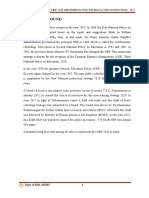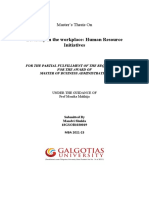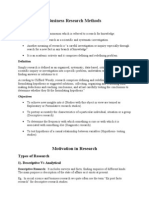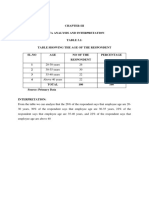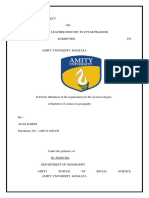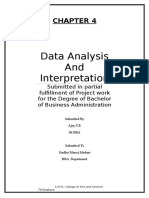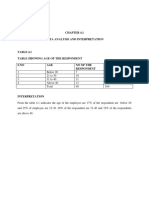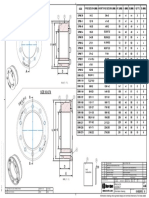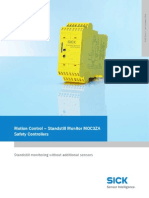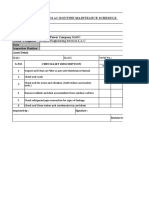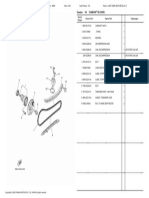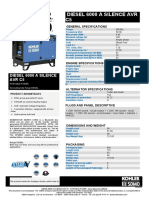CHAPTER IV ANALYSIS AND INTERPRETATION
Analysis of data is a process of inspecting, cleaning, transforming, and modeling data with the goal of highlighting useful information, suggesting conclusions, and supporting decision making. Data mining is a particular data analysis technique that focuses on modeling and knowledge discovery for predictive rather than purely descriptive purposes. Business intelligence covers data analysis that relies heavily on aggregation, focusing on business information. In statistical applications, some people divide data analysis into descriptive statistics, exploratory data analysis (EDA), and confirmatory data analysis (CDA). EDA focuses on discovering new features in the data and CDA on confirming or falsifying existing hypotheses. Predictive analytics focuses on application of statistical or structural models for predictive forecasting or classification, while text analytics applies statistical, linguistic, and structural techniques to extract and classify information from textual sources, a species of unstructured data. All are varieties of data analysis. In simple, Data analysis and interpretation is the process of assigning meaning to the collected information and determining the conclusions, significance, and implications of the findings. The steps involved in data analysis are a function of the type of information collected, however, returning to the purpose of the assessment and the assessment questions will provide a structure for the organization of the data and a focus for the analysis.
4.1 SIMPLE PERCENTAGE ANALYSIS
Simple percentage analysis is the method to represent raw stream of data as a percentage (a part in 100 percent) for better understanding of collected data. The formula is;
�Sl. No 1 2 3 4 5 Total
Interpretation
4.1.1 Table showing the Age group of Respondents TABLE 1 Age Group No. of Respondents Percentage Below 25 0 0 25-35 18 18 35-45 35 35 45-55 35 35 Above 55 12 12 100 100
The above table reveals that 18 percent of the respondents being to the age group of 2535, about 35 percent of them belong to the age group of 35-45, about 35 percent of the respondents belong to the age group of 45-55 and about 12 percent of them are above the age group of 55. There is no person less than 25.
�CHART 1 Chart showing the Age group of Respondents
Age group of Respondents
12% 35% 18%
0%
Less than 25 25-35 35-45 45-55 Above 55
35%
�Sl. No 1 2 3
4.1.2 Table showing the Gender of Respondents TABLE 2 Gender No. of Respondents Male 78 Female 22 100
Percentage 78 22 100
Interpretation The above table reveals that 78 percent of the respondents are male workers and the remaining 22 percent of workers are female workers in HLL. From this we can know that the majority of the respondents are male.
�CHART 2 Chart showing the Gender of Respondents
Gender
22%
Male Female
78%
�4.1.3 Table showing the Educational Qualification of Respondents TABLE 3 Sl. No Educational No. of Respondents Percentage Qualification 1 Below SSLC 1 1 2 SSLC 85 85 3 Graduation 12 12 4 P.G 2 2 Total 100 100
Interpretation The above table clearly stays that majority of the respondents are having the education only up to SSLC (85%). 12% of the respondents are graduates. There are 2% of respondents who are having a PG qualification. Only 1% of the respondents are having the educational qualification below SSLC.
�CHART 3 Chart showing the Educational Qualification of Respondents
Educational Qualification
P.G
Graduation
12
Educational Qualification
SSLC
85
Below SSLC
20
40
60
80
100
�Sl. No 1 2 Total
4.1.4 Table showing the marital status of Respondents TABLE 4 Marital Status No. of Respondents Percentage Married 98 98 Single / Unmarried 2 2 100 100
Interpretation From the above table we can know that majority (98%) of the respondents are married and only 2% are single.
�CHART 4 Chart showing the marital status of Respondents
Marital Status
2%
98%
Married Single / Unmarried
�4.1.5 Table showing the Level of Satisfaction of the Respondents on the Procedure Adopted for Career Growth of Workers TABLE 5 Sl. No Particulars No. of Respondents Percentage 1 2 3 4 5 Total Highly Satisfied Satisfied Moderately Satisfied Dissatisfied Highly Dissatisfied 9 16 66 9 0 100 9 16 66 9 0 100
Interpretation From the above table it is inferred that the most of the respondents are moderately satisfied with the Procedure Adopted for Career Growth of Workers in HLL. About 16 percent of the respondents are satisfied with it. 9 percent are highly satisfied and another 9 percent are dissatisfied with the Procedure Adopted for Career Growth of Workers in HLL. There are no on who are having any highly dissatisfied opinion about this particular issue.
�CHART 5 Chart showing the Level of Satisfaction of the Respondents on the Procedure Adopted for Career Growth of Workers
Procedure Adopted for Career Growth of Workers
70
66
60
Percentage of Respondents
50
40
30 Procedure Adopted for Career Growth of Workers
20
16 9 9 0
10
0 Highly Satisfied Satisfied Moderately Satisfied Dissatisfied Highly Disatisfied
�4.1.6 Table showing the Level of Satisfaction of the Respondents on theWorking Environment of HLL TABLE 6 Sl. No Particulars No. of Respondents Percentage 1 2 3 4 5 Total Highly Satisfied Satisfied Moderately Satisfied Dissatisfied Highly Dissatisfied 17 48 16 9 0 100 17 48 16 9 0 100
Interpretation From the above table it is inferred that the most of the respondents are moderately satisfied with the Procedure Adopted for Career Growth of Workers in HLL. About 16 percent of the
�CHART 6 Chart showing the Level of Satisfaction of the Respondents on theWorking Environment of HLL
Working Environment of HLL
Highly Satisfied
Dissatisfied
9 Working Environment of HLL
Moderately Satisfied
16
Satisfied
48
Highly Satisfied
17
10
20
30
40
50
60
Percentage of Respondents
�4.1.7 Table showing the Level of Satisfaction of the Respondents on theSafety practices for the welfare of the workers TABLE 7 Sl. No Particulars No. of Respondents Percentage 1 2 3 4 5 Total Highly Satisfied Satisfied Moderately Satisfied Dissatisfied Highly Dissatisfied 24 66 8 2 0 100 24 66 8 2 0 100
CHART 7 Chart showing the Level of Satisfaction of the Respondents on theSafety practices for the welfare of the workers
Safety practices for the welfare of the workers
70 60 Percentage of Respondents 50 40 30 20 10 0 Highly Satisfied Satisfied Moderately Satisfied Dissatisfied 8 2 0 Highly Dissatisfied 24 Safety practices for the welfare of the workers 66
�4.1.8Table showing the Level of Satisfaction of the Respondents on the Staff Benevolent fund TABLE 8 Sl. No Particulars No. of Respondents Percentage 1 2 3 4 5 Total Highly Satisfied Satisfied Moderately Satisfied Dissatisfied Highly Satisfied 9 51 29 5 6 100 9 51 29 5 6 100
CHART 8 Chart showing the Level of Satisfaction of the Respondents on theStaff Benevolent fund
Staff Benevolent fund
6% 9%
5%
Highly Satisfied Satisfied 29% Moderately Satisfied Dissatisfied 51% Highly Dissatisfied
�4.1.9 Table showing the Level of Satisfaction of the Respondents on theRecreation of employees TABLE 9 Sl. No Particulars No. of Respondents Percentage 1 2 3 4 5 Total Highly Satisfied Satisfied Moderately Satisfied Dissatisfied Highly Dissatisfied 31 44 19 4 2 100 31 44 19 4 2 100
CHART 9 Chart showing the Level of Satisfaction of the Respondents on the Recreation of employees
Recreation of employees
44 45
Percentage of Respondents
40 35 30 25 20 15 10 5 0 Highly Satisfied Satisfied Moderately Satisfied Dissatisfied Highly Dissatisfied 4 2 19 Recreation of employees 31
�4.1.10Table showing the Level of Satisfaction of the Respondents on the Educational assistance provided for childrens education TABLE 10 Sl. No Particulars No. of Respondents Percentage 1 2 3 4 5 Total Highly Satisfied Satisfied Moderately Satisfied Dissatisfied Highly Dissatisfied 8 45 30 14 3 100 8 45 30 14 3 100
CHART 10 Chart showing the Level of Satisfaction of the Respondents on theEducational assistance provided for childrens education
Educational assistance provided for childrens education
3% 14% Highly Satisfied Satisfied Moderately Satisfied Dissatisfied 30% 45% Highly Dissatisfied 8%
�4.1.11Table showing the Level of Satisfaction of the Respondents on the Organizations policy for death in harness TABLE 11 Sl. No Particulars No. of Respondents Percentage 1 2 3 4 5 Total Highly Satisfied Satisfied Moderately Satisfied Dissatisfied Highly Dissatisfied 20 44 18 14 4 100 20 44 18 14 4 100
CHART 11 Chart showing the Level of Satisfaction of the Respondents on theOrganizations policy for death in harness
Organizations policy for death in harness
Percentage of Respondents 50 40 30 20 20 10 0 Highly Satisfied Satisfied Moderately Satisfied 18 14 44 Organizations policy for death in harness
Dissatisfied Highly Dissatisfied
�4.1.12Table showing theLevel of Satisfaction of the Respondents on theAppreciation and recognition given to employees for their excellence TABLE 12 Sl. No Particulars No. of Respondents Percentage 1 2 3 4 5 Total Highly Satisfied Satisfied Moderately Satisfied Dissatisfied Highly Dissatisfied 14 42 23 15 6 100 14 42 23 15 6 100
CHART 12 Chart showing the Level of Satisfaction of the Respondents on theAppreciation and recognition given to employees for their excellence
Appreciation and recognition given to employees for their excellence
Dissatisfied; 15% Highly Dissatisfied; 6% Highly Satisfied; 14%
Moderately Satisfied; 23%
Satisfied; 42%
�4.1.13 Table showing the Level of Satisfaction of the Respondents on theAssistance for post death formalities of employees and relatives TABLE 13 Sl. No Particulars No. of Respondents Percentage 1 2 3 4 5 Total Highly Satisfied Satisfied Moderately Satisfied Dissatisfied Highly Dissatisfied 17 46 19 13 5 100 17 46 19 13 5 100
CHART 13 Chart showing the Level of Satisfaction of the Respondents on theAssistance for post death formalities of employees and relatives
50 45 Percentage of Respondents 40 35 30 25 20 15 10 5 0
Assistance for post death formalities of employees and relatives
46 Assistance for post death formalities of employees and relatives 17 19 13 5
Highly Satisfied
Satisfied
Moderately Satisfied Axis Title
Dissatisfied
Highly Dissatisfied
�1.1.14Table showing the Level of Satisfaction of the Respondentson the Retirement benefit TABLE 14 Sl. No Particulars No. of Respondents Percentage 1 2 3 4 5 Total Highly Satisfied Satisfied Moderately Satisfied Dissatisfied Highly Dissatisfied 2 35 20 31 12 100 2 35 20 31 12 100
CHART 14 Chart showing the Level of Satisfaction of the Respondents on theRetirement benefit
Retirement benefit
Highly Dissatisfied 12 Retirement benefit
Dissatisfied 20
31
Moderately Satisfied
Satisfied 2 0 5 10 15 20 25 30 35
35
Highly Satisfied
Percentage of Respondents
�4.1.15Table showing the Level of Satisfaction of the Respondents on the HRA TABLE 15 Sl. No Particulars No. of Respondents Percentage 1 2 3 4 5 Total Highly Satisfied Satisfied Moderately Satisfied Dissatisfied Highly Dissatisfied 3 63 22 4 8 100 3 63 22 4 8 100
CHART 15 Chart showing the Level of Satisfaction of the Respondents on theHRA
Highly Dissatisfied 8% Dissatisfied 4%
HRA
Highly Satisfied 3%
Moderately Satisfied 22% Satisfied 63%
�1.1.16Table showing the Level of Satisfaction of the Respondents on the Night shift allowance TABLE 16 Sl. No Particulars No. of Respondents Percentage 1 2 3 4 5 Total Highly Satisfied Satisfied Moderately Satisfied Dissatisfied Highly Dissatisfied 2 48 26 16 8 100 2 48 26 16 8 100
CHART 16 Chart showing the Level of Satisfaction of the Respondents on theNight shift allowance
Night shift allowance
50 45 Percentage of Respondents 40 35 30 25 20 15 10 5 0 Highly Satisfied Satisfied Moderately Satisfied Dissatisfied Highly Dissatisfied 2 16 8 26 48
Night shift
�4.1.17 Table showing the Level of Satisfaction of the Respondents on theCanteen Subsidy TABLE 17 Sl. No Particulars No. of Respondents Percentage 1 2 3 4 5 Total Highly Satisfied Satisfied Moderately Satisfied Dissatisfied Highly Dissatisfied 2 33 15 40 10 100 2 33 15 40 10 100
CHART 17 Chart showing the Level of Satisfaction of the Respondents on theCanteen Subsidy
Highly Dissatisfied 10%
Canteen Subsidy
Highly Satisfied 2%
Satisfied 33% Dissatisfied 40% Moderately Satisfied 15%
�4.1.18 Table showing the Level of Satisfaction of the Respondents on theFestival Allowance TABLE 18 Sl. No Particulars No. of Respondents Percentage 1 2 3 4 5 Total Highly Satisfied Satisfied Moderately Satisfied Dissatisfied Highly Dissatisfied 0 40 35 19 6 100 0 40 35 19 6 100
CHART 18 Chart showing the Level of Satisfaction of the Respondents on theFestival Allowance
Festival Allowance
Highly Dissatisfied 6 Festival Allowance
Dissatisfied
19
Moderately Satisfied
35
Satisfied
40
Highly Satisfied 0
0 10 20 Percentage of Respondents 30 40
�4.1.19Table showing the Level of Satisfaction of the Respondents on theRest room facility TABLE 19 Sl. No Particulars No. of Respondents Percentage 1 2 3 4 5 Total Highly Satisfied Satisfied Moderately Satisfied Dissatisfied Highly Dissatisfied 13 58 20 8 1 100 13 58 20 8 1 100
CHART 19 Chart showing the Level of Satisfaction of the Respondents on theRest room facility
Rest room facility
Dissatisfied 8% Moderately Satisfied 20% Highly Dissatisfied 1% Highly Satisfied 13%
Satisfied 58%
�4.1.20 Table showing the Level of Satisfaction of the Respondents on theTraining Programs Conducted TABLE 20 Sl. No Particulars No. of Respondents Percentage 1 2 3 4 5 Total Highly Satisfied Satisfied Moderately Satisfied Dissatisfied Highly Dissatisfied 7 54 30 6 3 100 7 54 30 6 3 100
CHART 20 Chart showing the Level of Satisfaction of the Respondents on theTraining Programs Conducted
Training Programs Conducted
6% 3% 7%
Highly Satisfied Satisfied
30%
Moderately Satisfied Dissatisfied
54%
Highly Satisfied
�4.1.21 Table showing the Level of Satisfaction of the Respondents on theUniform allowance TABLE 21 Sl. No Particulars No. of Respondents Percentage 1 2 3 4 5 Total Highly Satisfied Satisfied Moderately Satisfied Dissatisfied Highly Dissatisfied 8 45 22 22 3 100 8 45 22 22 3 100
CHART 21 Chart showing the Level of Satisfaction of the Respondents on theUniform allowance
Uniform allowance
50 45 Percentage of Respondents 40 35 30 25 20 15 10 5 0 Highly Satisfied Satisfied Moderately Satisfied Dissatisfied
45
Uniform allowance
22 8
22
3
Highly Dissatisfied
�4.1.22 Table showing the Level of Satisfaction of the Respondents on theCounseling process TABLE 22 Sl. No Particulars No. of Respondents Percentage 1 2 3 4 5 Total Highly Satisfied Satisfied Moderately Satisfied Dissatisfied Highly Dissatisfied 10 49 30 8 3 100 10 49 30 8 3 100
CHART 22 Chart showing the Level of Satisfaction of the Respondents on theCounseling process
Counseling process
3% 8% 10%
Highly Satisfied Satisfied
30% 49%
Moderately Satisfied Dissatisfied Highly Dissatisfied
�4.1.23 Table showing the Level of Satisfaction of the Respondents on theFirst aid TABLE 23 Sl. No Particulars No. of Respondents Percentage 1 2 3 4 5 Total Highly Satisfied Satisfied Moderately Satisfied Dissatisfied Highly Dissatisfied 30 53 12 4 1 100 30 53 12 4 1 100
CHART 23 Chart showing the Level of Satisfaction of the Respondents on theFirst aid
First aid
Highly Dissatisfied Dissatisfied Moderately Satisfied Satisfied Highly Satisfied 0 10 20 30
1 4 12 53 30
40 50 60
First aid
Percentage of Respondents
�4.1.24 Table showing the Level of Satisfaction of the Respondents on the Grievance handling procedure in the company TABLE 24 Sl. No Particulars No. of Respondents Percentage 1 2 3 4 5 Total Highly Satisfied Satisfied Moderately Satisfied Dissatisfied Highly Dissatisfied 22 62 16 0 0 100 22 62 16 0 0 100
CHART 24 Chart showing the Level of Satisfaction of the Respondents on theGrievance handling procedure in the company
Grievance handling procedure in the company
Highly Dissatisfied Dissatisfied Moderately Satisfied Satisfied Highly Satisfied 0 10 20 22 30 40 50 60 70 0 0 16 62 Grievance handling procedure in the company
Perecentage of Respondents
�4.1.25Table showing the Level of Satisfaction of the Respondents on theWork shift timings. TABLE 25 Sl. No Particulars No. of Respondents Percentage 1 2 3 4 5 Total Highly Satisfied Satisfied Moderately Satisfied Dissatisfied Highly Dissatisfied 41 51 8 0 0 100 41 51 8 0 0 100
CHART 25 Chart showing the Level of Satisfaction of the Respondents on theWork shift timings.
Work shift timings.
60 51 50 41 Axis Title 40 30 20 10 0 Highly Satisfied Satisfied Moderately Satisfied Dissatisfied Highly Dissatisfied 8 0 0
�4.1.26Table showing the Level of Satisfaction of the Respondents on theTransport facilities TABLE 26 Sl. No 1 2 3 4 5 Total Particulars Highly Satisfied Satisfied Moderately Satisfied Dissatisfied Highly Dissatisfied No. of Respondents 20 56 19 3 2 100 Percentage 20 56 19 3 2 100
CHART 26 Chart showing the Level of Satisfaction of the Respondents on theTransport facilities
Transport facilities
Dissatisfied 3%
Highly Dissatisfied 2%
Moderately Satisfied 19%
Highly Satisfied 20%
Satisfied 56%
�4.1.27 Table showing the existence of Housing facility in the company. TABLE 27 Sl. No Particulars No. of Respondents Percentage 1 2 3 Total Yes No No Opinion 97 0 3 100 97 0 3 100
CHART 27 Chart showing the existence of Housing facility in the company
Housing facility in the company
120 100
97
Percentage of Respondents
80 60 40 20 0 Yes Housing facility in the company
0
No
3
No Opinion
�4.1.28 Table showing the existence of Recreation facility in the company. TABLE 28 Sl. No Particulars No. of Respondents Percentage 1 2 3 Total Yes No No Opinion 98 0 3 100 98 0 3 100
CHART 28 Chart showing the existence ofRecreation facility in the company
Recreation facility in the company
120 100
98
Percentage of Respondents
80 60 40 20 0 Yes Recreation facility in the company
0
No
3
No Opinion
�4.1.29 Table showing the existence of Uniform facility in the company. TABLE 29 Sl. No Particulars No. of Respondents Percentage 1 2 3 Total Yes No No Opinion 100 0 0 100 100 0 0 100
CHART 29 Chart showing the existence ofUniform facility in the company
Uniform facility in the company
120 100
100
Percentage of Respondents
80 60 40 20 0 Yes Uniform facility in the company
0
No
0
No Opinion
�4.1.30 Table showing the existence of Health Insurance facility in the company. TABLE 30 Sl. No Particulars No. of Respondents Percentage 1 2 3 Total Yes No No opinion 99 0 1 100 99 0 1 100
CHART 30 Chart showing the existence ofHealth Insurance facility in the company
Health Insurance facility in the company
120 100
99
Percentage of Respondents
80 60 40 20 0 Yes Health Insurance facility in the company
0
No
1
No Opinion
�4.1.31 Table showing the existence of Conducive Working Conditions facility in the company. TABLE 31 Sl. No Particulars No. of Respondents Percentage 1 2 3 Total Yes No No Opinion 98 0 2 100 98 0 2 100
CHART 31 Chart showing the existence ofWorking Conditions facility in the company.
Working Conditions facility in the company.
120 100
98
Percentage of Respondents
80 60 40 20 0 Yes Working Conditions facility in the company.
0
No
2
No Opinion
�4.1.32 Table showing the existence of Lighting and Ventilation facility in the company TABLE 32 Sl. No Particulars No. of Respondents Percentage 1 2 3 Total Yes No No Opinion 99 0 1 100 99 0 1 100
CHART 32 Chart showing the existence ofLighting and Ventilation facility in the company
Lighting and Ventilation facility in the company
120 100
99
Percentage of Respondents
80 60 40 20 0 Yes Lighting and Ventilation facility in the company
0
No
1
No Opinion
�4.1.33 Table showing the existence of Safe Drinking Water facility in the company. TABLE 33 Sl. No Particulars No. of Respondents Percentage 1 2 3 Total Yes No NO Opinion 99 0 1 100 99 0 1 100
CHART 33 Chart showing the existence ofSafe Drinking Water facility in the company
Safe Drinking Water facility in the company
120 100
99
Percentage of Respondents
80 60 40 20 0 Yes Safe Drinking Water facility in the company
0
No
1
No Opinion
�4.1.34 Table showing the existence of Rest room facility in the company TABLE 34 Sl. No Particulars No. of Respondents Percentage 1 2 3 Total Yes No No Opinion 98 0 2 100 98 0 2 100
CHART 34 Chart showing the existence ofRest room facility in the company
Rest room facility in the company
120 100
98
Percentage of Respondents
80 60 40 20 0 Yes Rest room facility in the company
0
No
2
No Opinion
�4.1.35 Table showing that, whether the respondent leaves the work place for complains about the working conditions in aday TABLE 35 Sl. No Particulars No. of Respondents Percentage 1 2 3 Total Always Often Sometimes Rarely 6 40 54 100 6 40 54 100
CHART 35 Chart showing that, whether the respondent leaves the work place for complains about the working conditions in a day
Leaves the work place for complains about the working conditions in a day
6%
54%
40%
Always Often Sometimes
�4.1.36 Table showing the first objective of respondents in the company TABLE 36 Sl. No Particulars No. of Percentage Respondents 1 Higher Productivity 33 33 2 Industrial Peace and Harmony 12 12 3 Welfare Programs 47 47 4 Others 8 8 Total 100 100 CHART 36 Chart showing the first objective of respondents in the company
First objective of respondents in the company
50 Percentage of Respondents 40 30 First objective of respondents in the company
47
20 10 0 Higher Productivity Industrial Peace and Harmony Welfare Programs Others
33 12 8








